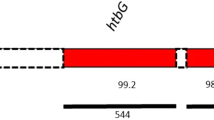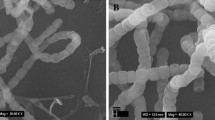Abstract
Acinetobacter calcoaceticus HIRFA32 from wheat rhizosphere produced catecholate type of siderophore with optimum siderophore (ca. 92 % siderophore units) in succinic acid medium without FeSO4 at 28 °C and 24 h of incubation. HPLC purified siderophore appeared as pale yellow crystals with molecular weight [M+1] m/z 347.18 estimated by LCMS. The structure elucidated by 1H NMR, 13C NMR, HMQC, HMBC, NOESY and decoupling studies, revealed that siderophore composed of 2,3-dihydroxybenzoic acid with hydroxyhistamine and threonine as amino acid subunits. In vitro study demonstrated siderophore mediated mycelium growth inhibition (ca. 46.87 ± 0.5 %) of Fusarium oxysporum. This study accounts to first report on biosynthesis of acinetobactin-like siderophore by the rhizospheric strain of A. calcoaceticus and its significance in inhibition of F. oxysporum.


Similar content being viewed by others
References
Huddedar SB, Shete AM, Tilekar JN, Gore SD, Dhavale DD, Chopade BA (2002) Isolation, characterization and plasmid pUPI126 mediated indole 3 acetic acid (IAA) production in Acinetobacter strains from rhizosphere of wheat. Appl Biochem Biotechnol 102:21–29
Rokhbakhsh-Zamin F, Sachdev D, Kazemi-Pour N, Engineer A, Pardesi KR, Zinjarde SS, Dhakephalkar PK, Chopade BA (2011) Characterization of plant growth promoting traits of Acinetobacter species isolated from rhizosphere of Pennisetum glaucum. J Microbiol Biotech 21:556–566
Sachdev D, Nema P, Dhakephalkar P, Zinjarde S, Chopade B (2010) Assessment of 16S rRNA gene based phylogenetic diversity of Acinetobacter community from the rhizosphere of wheat. Microbiol Res 165:627–638
Sorensen J, Van Elsas JD, Trevors JT, Wellington EMH (1997) The rhizosphere as a habitat for soil microorganisms. Modern soil microbiology. Marcel Dekker, New York, pp 21–45
Bais HP, Park SW, Weir TL, Callaway RM, Vivanco JM (2004) How plants communicate using the underground information superhighway. Trends Plant Sci 9:26–32
Glick BR (1995) The enhancement of plant growth by free-living bacteria. Can J Microbiol 41:109–117
Sturz A, Christie VBR (2003) Beneficial microbial allelopathies in the root zone: the management of soil quality and plant disease with rhizobacteria. Soil Tillage Res 72:107–123
Bakker PAHM, Ran LX, Pieterse CMJ, van Loon LC (2003) Understanding the involvement of rhizobacteria mediated induction of systemic resistance in biocontrol of plant diseases. Can J Plant Pathol 25:5–9
Whipps JM (2001) Microbial interactions and biocontrol in the rhizosphere. J Exp Bot 52:487–511
Carson KC, Glenn AR, Dilworth MJ (1994) Specificity of siderophore—mediated transport of iron in rhizobia. Arch Microbiol 161:333–339
Cornish AS, Page WJ (1995) Production of the tricatecholate siderophore protochelin by Azotobacter vinelandii. Biometals 8:332–338
Dilworth MJ, Carson KC, Giles RGF, Byrne LT, Glenn AR (1998) Rhizobium leguminosarum bv. viciae produces a novel cyclic trihydroxamate siderophore, vicibactin. Microbiology 144:781–791
Storey EP, Boghozian R, Little JL, Lowman DW, Chakraborty R (2006) Characterization of ‘Schizokinen’; a dihydroxamate-type siderophore produced by Rhizobium leguminosarum IARI 917. Biometals 19:637–649
Dhakephalkar PK, Chopade BA (1994) High levels of multiple metal resistance and its correlation to antibiotic resistance in environment isolates of Acinetobacter. Biometals 7:67–74
Philippe J, Bouvet Patrick M, Grimont AD (1986) Taxonomy of the genus Acinetobacter with the Recognition of Acinetobacter baumannii sp. nov. Acinetobacter haemolyticus sp. nov. Acinetobacter johnsonii sp. nov. and Acinetobacter junii sp. nov. and emended descriptions of Acinetobacter calcoaceticus and Acinetobacter lwoffii. Int J Syst Bacteriol 36:228–240
Chopade BA, Huddedar SB, Shete AM, Tilekar JN, Gore SD, Dhavale DD (2008) Plasmid encoding IAA and method thereof. US Pat 7:341–868
Egamberdieva D, Kamilova F, Validov S, Gafurova L, Kucharova Z, Lugtenberg B (2008) High incidence of plant growth-stimulating bacteria associated with the rhizosphere of wheat grown on salinated soil in Uzbekistan. Environ Microbiol 1:1–9
Indiragandhi P, Anandham R, Madhaiyan M, Sa TM (2008) Characterization of plant growth-promoting traits of bacteria isolated from larval guts of diamond back moth Plutella xylostella (lepidoptera: plutellidae). Curr Microbiol 56:327–333
Liu CH, Chen X, Liu TT, Lian B, Yucheng Gu, Caer V, Xue YR, Wang BT (2007) Study of the antifungal activity of Acinetobacter baumannii LCH001 in vitro and identification of its antifungal components. Appl Microbiol Biotechnol 76:459–466
Luo M, Fadeev EA, Groves JT (2005) Membrane dynamics of the amphiphilic siderophore, acinetoferrin. J Am Chem Soc 127:1726–1736
Okujo N, Sakakibara Y, Yoshida T, Yamamoto S (1994) Structure of acinetoferrin, a new citrate-based dihydroxamate siderophore from Acinetobacter haemolyticus. Biometals 7:170–176
Yamamoto S, Okujo N, Sakakibara Y (1994) Isolation and structure elucidation of acinetobactin, a novel siderophore from Acinetobacter baumannii. Arch Microbiol 162:249–252
Yavankar SP, Pardesi KR, Chopade BA (2007) Species distribution and physiological characterization of Acinetobacter genospecies from healthy human skin of tribal population in India. Indian J Med Microbiol 25:336–345
Rawlings DE (1995) Restriction enzyme analysis of 16S rRNA genes for the rapid identification of Thiobacillus ferrooxidans, Thiobacillus thiooxidans and Leptospirillum ferrooxidans strains in leaching environments. In: Jerez CA, Vargas T, Toledo H, Wiertz JV (eds) Biohydrometallurgical processing. University of Chile Press, Santiago, pp 9–17
Tamaoka J, Kamagata K (1984) Determination of DNA base composition by reversed phase high performance liquid chromatography. FEMS Microbiol Lett 25:125–128
Mesbah M, Premachandran U, Whitman W (1989) Precise measurement of G + C content of deoxyribonucleic acid by high performance liquid chromatography. Int J Syst Bacteriol 39:159–167
Cashion P, Hodler-Franklin MA, McCully J, Franklin M (1977) A rapid method for base ratio determination of bacterial DNA. Anal Biochem 81:461–466
De Lay JH, Cattior ReynaertsA (1970) The quantitative measurement of DNA hybridization from renaturation rates. Eur J Biochem 12:133–142
Huss VAR, Festl H, Schleifer KH (1983) Studies on the spectrophotometric determination of DNA hybridization from renaturation rates. Syst Appl Microbiol 4:184–192
Schwyn BJ, Neilands B (1987) Universal chemical assay for the detection and determination of siderophores. Anal Biochem 160:47–56
Machuca A, Milagres AMF (2003) Use of CAS agar plate modified to study the effect of different variables on the siderophore production by Aspergillus. Lett Appl Microbiol 36:177–181
Payne SM (1994) Detection, isolation and characterization of siderophores. Methods Enzymol 235:329–344
Hathway DE (1969) Plant phenols and tannins. In: Smith I (ed) Chromatographic and electrophoretic techniques, 3rd edn. Interscience Publishers Inc., New York, pp 390–436
Meyer JM, Abdallah MA (1978) The fluorescent pigment of Pseudomonas fluorescens: biosynthesis, purification and physiochemical properties. J Gen Microbiol 107:319–328
Sridevi M, Mallaiah KV (2008) Production of hydroxamate-type of siderophores by Rhizobium strains from Sesbania sesban (L.). Merr. Int J Soil Sci 3:24–28
Jalal MAF, Helm VD (1991) Isolation and spectroscopic identification of fungal siderophores. In: Winkelmann G (ed) Handbook of microbial iron chelates. CRC Press, Boca Raton, pp 235–236
Kumar NR, Arasu VT, Gunasekaran P (2002) Genotyping of antifungal compounds producing plant growth-promoting rhizobacteria, Pseudomonas fluorescence. Curr Sci 82:1463–1466
Postle K (1990) Aerobic regulation of the Escherichia coli tonB genes by changes in iron availability and the fur locus. J Bacteriol 172:2287–2293
Moon CD, Zhang X, Matthijs S, Schäfer M, Budzikiewicz H, Rainey PB (2008) Genomic, genetic and structural analysis of pyoverdine-mediated iron acquisition in the plant growth-promoting bacterium Pseudomonas fluorescens SBW25. BMC Microbiol 8:7
De Rijk P, Van de Peer Y, Chapelle S, De Wachter R (1994) Database on the structure of large ribosomal subunit RNA. Nucleic Acids Res 22:3495–3501
Maidak BL, Larsen N, McCaughey MJR, OverbeekOlsen GJ, Fogel K, Blandy J, Woese CR (1994) The ribosomal database project. Nucleic Acids Res 22:3485–3487
Van de Peer Y, Van den Broeck I, De Rijk P, De Wachter R (1996) Database on the structure of small ribosomal subunit RNA. Nucleic Acids Res 22:3488–3494
Stackebrandt EB, Goebel M (1994) Taxonomic note: a place for DNA–DNA reassociation and 16S rRNA sequence analysis in the present species definition in bacteriology. Int J Syst Bacteriol 44:846–849
Chun J, Lee JH, Jung Y, Kim M, Kim S, Kim BK, Lim YW (2007) Eztaxon: a web-based tool for the identification of prokaryotes based on 16S ribosomal RNA gene sequences. Int J Syst Evol Microbiol 57:2259–2261
Stackebrandt E, Ebers J (2006) Taxonomic parameters revisited: tarnished gold standards. Microbiol Today 33:152–155
Biomerieux Vitek, Inc. (1992) 20e Analytical profile index, 10th edn. Biomerieux Vitek Inc, Hazelwood
Bergan T, Sorheim K (1984) Gas–liquid chromatography for the assay of fatty acid composition in Gram-negative bacilli as an aid to classification. Methods Microbiol 15:345–362
Carr EL, Kampfer P, Patel BK, Gurtler V, Seviour RJ (2003) Seven novel species of Acinetobacter isolated from activated sludge. Int J Syst Evol Microbiol 53:953–963
Wayne LG, Brenner DJ, Colwell RR, Grimont PAD, Kandler O, Krichevsky MI, Moore LH, Moore WEC, Murray RGE, Stackebrandt E, Starr MP, Truper HG (1987) Report of the ad hoc committee on reconciliation of approaches of bacterial systemic. Int J Syst Bacteriol 37:463–464
Wandersman C, Delepelaire P (2004) Bacterial iron sources: from siderophores to hemophores. Annu Rev Microbiol 58:611–647
Arnow LE (1937) Colorimetric determination of the components of 3,4-dihydroxyphenylalanine-tyrosine mixtures. J Biol Chem 118:531–537
Crosa JH, Walsh CT (2002) Genetics and assembly line enzymology of siderophore biosynthesis in bacteria. Microbiol Mol Biol Rev 66:223–249
Sayyed RZ, Badgujar MD, Sonawane HM, Mhaaske MM, Chincholkar SB (2005) Production of microbial iron chelators (siderophores) by fluorescent Pseudomonas. Indian J Biotechnol 4:484–490
Sayyed RZ, Chincholkar SB (2006) Purification of siderophores of Alcaligenes faecalis on Amberlite XAD. Bioresource Technol 97:1026–1029
Patel AK, Deshattiwar MK, Chaudhari BL, Chincholkar SB (2008) Production, purification and chemical characterization of the catecholate siderophore from potent probiotic strains of Bacillus spp. Bioresour Technol 100:368–373
Dorsey CW, Tomaras AP, Connerly PL, Tolmasky ME, Crosa JH, Actis LA (2004) The siderophore-mediated iron acquisition systems of Acinetobacter baumannii ATCC 19606 and Vibrio anguillarum 775 are structurally and functionally related. Microbiol 150:3657–3667
Acknowledgments
We thank Department of Biotechnology (DBT), Govt. of India, New Delhi (Project Sanction No. BT/PR6454/AGR/05/302/2005) for the financial support.
Author information
Authors and Affiliations
Corresponding author
Electronic Supplementary Material
Below is the link to the electronic supplementary material.
Rights and permissions
About this article
Cite this article
Maindad, D.V., Kasture, V.M., Chaudhari, H. et al. Characterization and Fungal Inhibition Activity of Siderophore from Wheat Rhizosphere Associated Acinetobacter calcoaceticus Strain HIRFA32. Indian J Microbiol 54, 315–322 (2014). https://doi.org/10.1007/s12088-014-0446-z
Received:
Accepted:
Published:
Issue Date:
DOI: https://doi.org/10.1007/s12088-014-0446-z




